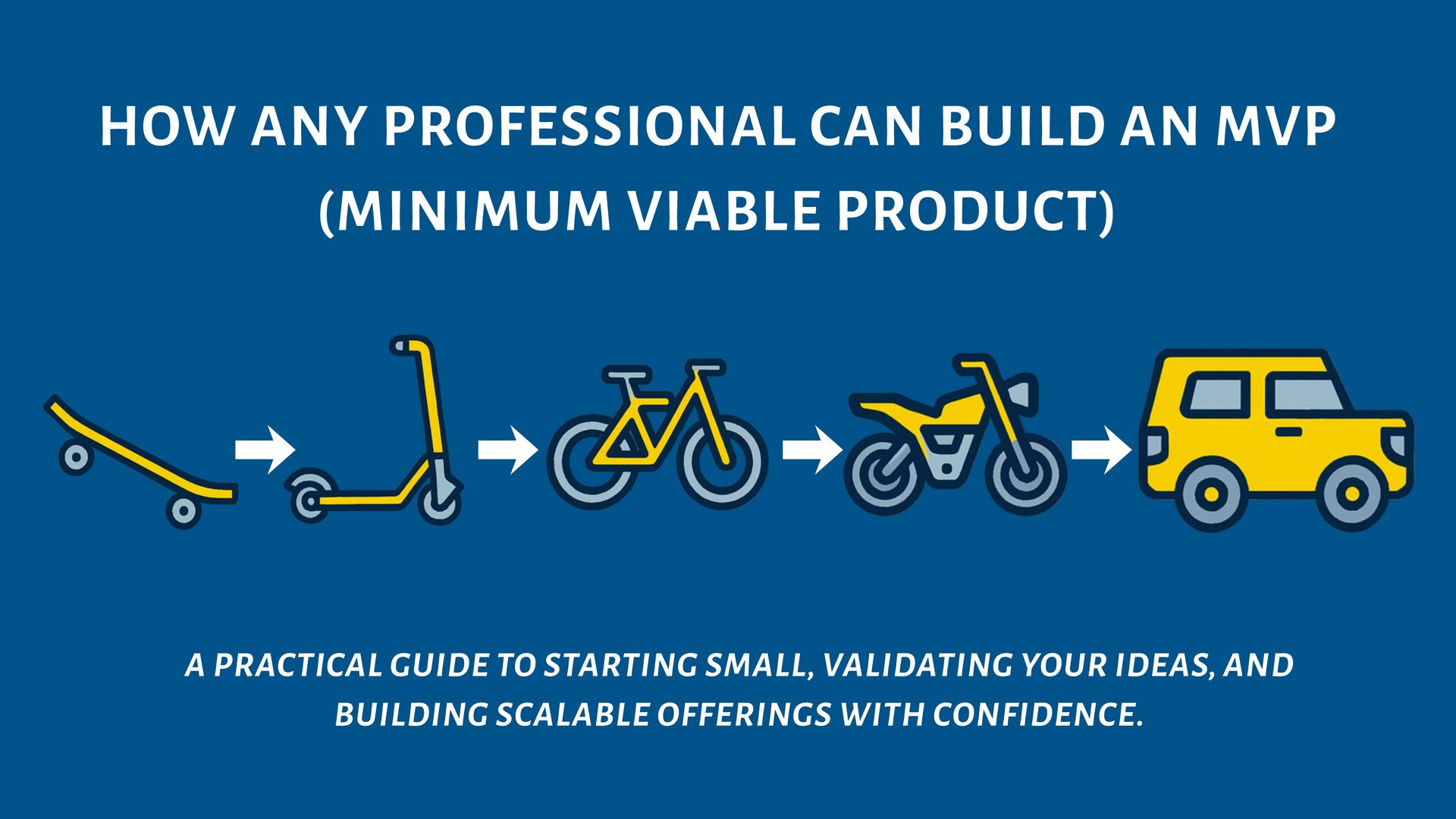- Kevin's Newsletter
- Posts
- How Any Professional Can Build an MVP (Minimum Viable Product)
How Any Professional Can Build an MVP (Minimum Viable Product)
A practical guide to starting small, validating your ideas, and building scalable offerings with confidence.

Most professionals stall because they assume an MVP means a fully-featured product, lots of investment and months of development. In reality, an MVP is simply the smallest version that delivers value and allows you to test market demand, collect feedback, and iterate.

Image Courtesy of - www.upsilonit.com
My first MVP was a simple $150 LinkedIn Growth course. It earned $600 in my first ten months of creating, but more importantly, it proved there was real demand for what I taught. It started as a three-hour 1:1 training session, nothing fancy—just the smallest version of value I could deliver quickly. Over time, I expanded it into a five-module, video-on-demand course that now serves as the flagship inside my LinkedIn Growth Community, Ignite, on the Skool platform.
Today, students pay one monthly fee and gain access to all my courses, guides, and videos. The entire system grew from that one small MVP—proof that starting lean can build something scalable.

The Founder’s Course located in my Ignite Community
Why Launch an MVP?
Here are the key advantages, captured visually and expanded for your professional audience:
Hypothesis testing & market-validation: Launching an MVP means you validate your idea early, ensuring you’re solving a real problem rather than assuming one.
Higher chances to secure stakeholders or investors: By showing a working solution (even a minimal one) you reduce risk and gain credibility.
Mitigating waste: By cutting development to only what’s essential, you avoid creating features no one uses — saving time, money and frustration.
Freeing the team from irrelevant work: A tight MVP scope keeps focus on high-impact work instead of scattered tasks that don’t matter.
Accelerated development & quicker release: Since you’re only building what matters now, you get to market fast and begin learning sooner.
Getting first traction, early adopters, and possible revenue: Early users = early feedback = early proof. That’s gold.
Avoiding major strategic mistakes / discovering when to pivot: If something doesn’t work, you find out early before you’ve invested too much and locked-in.
Building a better product based on real feedback: Once the MVP is out, you refine with actual user input — making something users want, not what you presume they want.

Image Courtesy of - www.upsilonit.com
A Breathing-Room Process for Professionals
Here’s how you can apply a structured yet lightweight approach:
Discovery – Understand your target audience and their pain-points. What are the processes, tools, gaps they currently deal with?
Strategy – Define what the MVP will include (and more importantly what it will not). Prioritize quick wins. Establish a roadmap for future phases.
Implementation – Launch the MVP to a small, focused user segment. Keep scope tight. Make sure the right stakeholders are involved.
Launch & Iterate – Monitor usage, collect feedback. If users don’t show excitement, pause and uncover why. Adjust and improve.
Sample MVP Ideas for Professionals (Beyond LinkedIn Growth)
Here are examples of quick-to-launch MVPs across various business functions:
Marketing
A landing page for a new service to test conversion.
A short video series validating message-market fit.
A lead magnet (e.g., guide/checklist) to test demand.
Sales
A pilot offer sold to a small group at a lower price.
A scripted outreach sequence to test interest before building full CRM workflows.
Two price tiers offered for the same service to test willingness to pay.
Operations
A simplified workflow map replacing a manual process.
A spreadsheet or basic tool that automates part of the task.
A 2-week trial of a new team structure to test impact.
Training / Development
A 30-minute workshop for a niche skill.
An email-course (5-7 emails) to validate interest in a longer program.
A template or worksheet pack sold or given to early adopters.
Product / Innovation
A clickable prototype (in Figma or similar) showing core functionality.
A concierge service that replicates what the product would deliver (manually) to test demand.
A waitlist or sign-up page with “coming soon” messaging to gauge interest.
Takeaway for You
Don’t aim for perfection.
Don’t build everything, hoping someone will adopt it.
Instead: launch something small, measure meaningful signals, iterate fast.
You’ll learn more from feedback than from theoretical planning.
You’ll save resources by focusing on what matters now.
You’ll build momentum and credibility, not just features.
An MVP isn’t about perfection — it’s about movement. When you start small, you create space to learn, adjust, and build with clarity. My own journey began with a simple $150 course, and that single step became the foundation for an entire community. The same principle applies to any professional: launch the smallest version that delivers value, gather real feedback, and let your audience guide the evolution. Progress comes from testing, not waiting. Start now, refine as you grow, and build something that lasts.
Call to Action!
If you want help designing your MVP — from defining the audience and problem, to crafting the minimal version, to planning your next steps — drop me a message. Let’s build something people actually want.

Spots are limited. Register Today!!
Free LinkedIn Growth Workshop
📌 I'm hosting a free 1.5-hour workshop on November 22nd at 9:00 AM Central Standard Time on the 5 Secrets to Growing Your Personal Brand and Monetizing your Digital Business.
Everyone who signs up and attends will receive my Visual Carousels Masterclass free for attending.
𝗖𝗹𝗶𝗰𝗸 𝗵𝗲𝗿𝗲 𝘁𝗼 𝗿𝗲𝗴𝗶𝘀𝘁𝗲𝗿 𝗳𝗼𝗿 𝘁𝗵𝗲 𝘄𝗼𝗿𝗸𝘀𝗵𝗼𝗽:
https://lnkd.in/eiJMVp8b
Reply